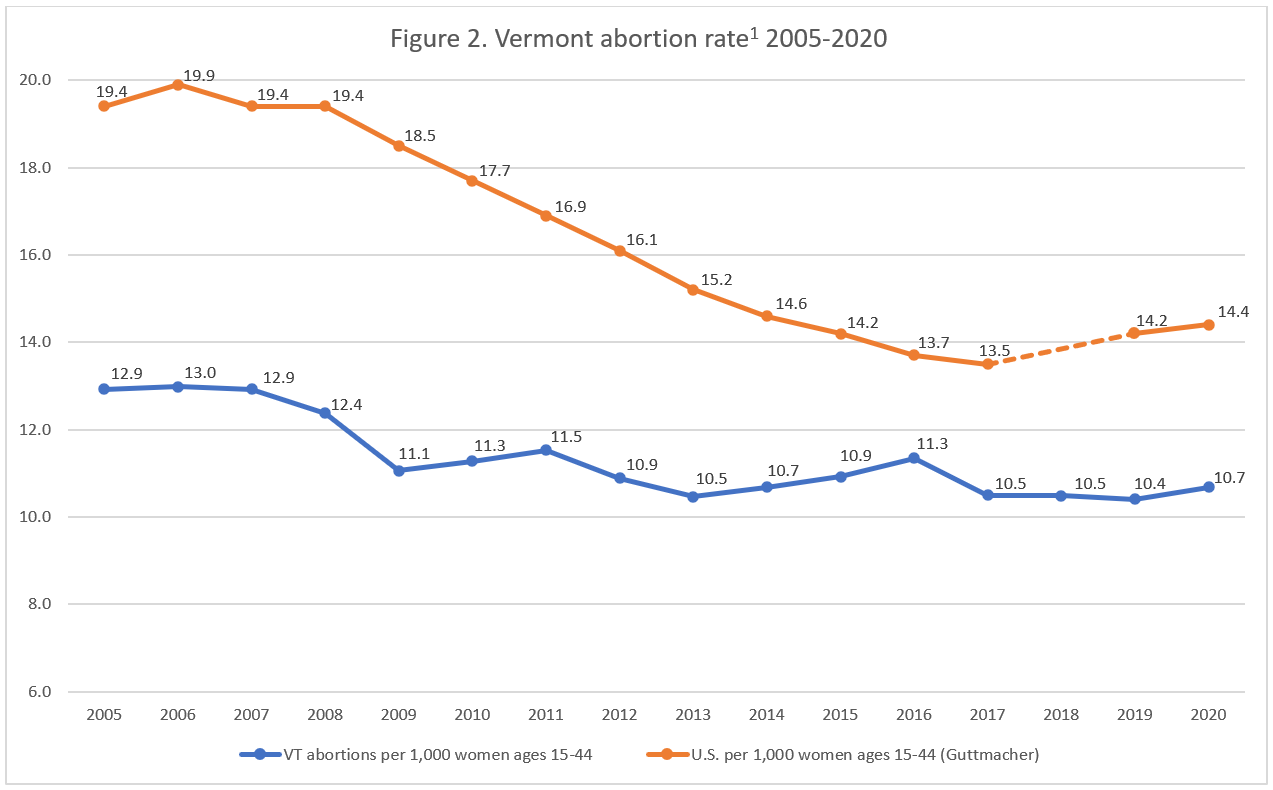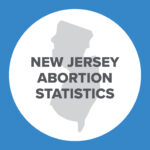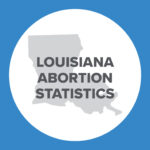Abortion Reporting: Vermont (2020)
Vermont’s 2020 abortion statistics were published online as part of the state’s full vital statistics report in July 2022. The report is available on the website of the Vermont Department of Health.
Statistics and Changes in Vermont Abortions, 2019-2020

The report does not include information on Planned Parenthood’s Vermont abortion market share.
Abortion Totals and Trends
There were 1,227 abortions reported in Vermont in 2020, an increase of 32 abortions (3 percent) from the prior year (Fig. 1). Chemical abortions increased 31 percent from 708 in 2019 to 926 in 2020. The Charlotte Lozier Institute (CLI) estimates that Vermont’s abortion rate fell by less than one percent to 10.2 abortions per 1,000 women ages 15 to 44 (Fig. 2). Of the 35 states that have reported abortion statistics for 2020, 22 states (including Vermont) have reported abortions increasing.
State Report Summary
In 2020, 83 percent of the abortions reported in Vermont were performed on state residents, while 17 percent were performed on nonresident women, including 11 percent on women from New Hampshire. Eight percent of Vermont abortions were performed on girls ages 19 or younger (with three percent on girls under the age of 18). Twenty-seven percent were performed on women ages 20 to 24, and 27 percent were obtained by women ages 25 to 29. Just over a third (34 percent) of abortions were performed on women ages 30 to 39. Five percent were on women who were age 40 or older.
Eighty-eight percent of the abortions occurring in Vermont were performed on white women. Five percent were on black women, and four percent were on Asian or Pacific Islander women. There were seven abortions on American Indian women and 13 on women of other races. Race was not reported for one percent of the abortions. CLI estimates that Vermont’s black abortion rate (23.9 abortions per 1,000 black women, ages 15 to 44) was 2.4 times higher than the white abortion rate (10).
Just over half of the abortions (51 percent) were performed on women with no children. Twenty-one percent were on women with one child, and 28 percent were on women with two or more children. Twenty percent of the abortions were performed on women who were married or separated. Sixty-nine percent were on unmarried women, and 11 percent were on women of unknown marital status.
Twenty-nine percent of Vermont abortions were on women who had a high school degree. Forty-two percent of abortions were on women who had attended college, with 21 percent on women with one to three years of college and another 21 percent on women with four or more years. Six percent were performed on women with less than a high school education. Education was not reported for 22 percent of the abortions.
Eighty-five percent of Vermont abortions were performed before nine weeks gestation. Ten percent were performed between nine and 10 weeks, and four percent each occurred between 11 to 12 weeks and 13 to 15 weeks of gestation. Three percent were reported from 16 to 20 weeks. Fourteen abortions, 1.1 percent of the total, were performed at 21 weeks of gestation or later. The total exceeded 100 percent because of rounding.
A majority of Vermont abortions, 75 percent, were chemical. Nineteen percent were suction curettage procedures, and six percent were performed using a different procedure. Ninety-two percent of the abortions occurred in abortion clinics, while six percent occurred in hospitals and two percent were performed in doctor’s offices.
Article 22 Amendment/Prop. 5
Proposition 5, also now known as the Amendment to Article 22 of the Vermont Constitution, was first introduced in the State Senate in 2019. It received majority (two-thirds) approval in the State Senate in 2020 and a majority House approval in 2021. The text of the amendment states that the proposal would declare the right to “personal reproductive liberty” and “amend the Constitution of the State of Vermont to ensure that every Vermonter is afforded personal reproductive liberty.” The amendment would also add to Article 22 of Chapter 1 of the Vermont Constitution “[t]hat an individual’s right to personal reproductive autonomy is central to the liberty and dignity to determine one’s own life course and shall not be denied or infringed…” The amendment will be up for public vote on the November 2022 ballot. As Mary Beerworth, the Executive Director of Vermont Right to Life, noted, “An unborn child would be treated as less than the 215 plants and animals that have protection — legal protection — in the state of Vermont.” Other opponents of the amendment have rightly categorized it as “vague and permissive of late-term abortions.”
State Ranking
In 2016, CLI evaluated abortion reporting across the 50 states, the District of Columbia, and New York City. Vermont’s reporting tied for 31st best. Since Vermont uses state funds to pay for abortions for Medicaid-eligible women, the state could report the method of payment for each abortion. Vermont could also report whether any abortions resulted in complications and the reasons why women had an abortion.

- Rates were calculated by CLI using the following formula: (total number of abortions performed in Vermont ÷ number of resident women ages 15-44) x 1,000. Rates may differ slightly from previous CLI articles due to revised population estimates. Population estimates were obtained from the CDC WONDER database.Estimates for 2005-2009 are intercensal estimates of the July 1 resident population. Estimates for 2010-2020 are Vintage 2020 postcensal estimates of the July 1 resident population. Estimates were produced by the U.S. Census Bureau and the National Center for Health Statistics.




























